The Zoo Med Large Double Door Paludarium is a stunning display piece and makes for a stand-out addition to any reptile or aquarium room.
The reptile and amphibian keeping hobby has undergone revolutionary changes, especially in more recent times. The diversity of products available to the average hobbyist is staggering when compared to what was once a very small niche in years past. Growing up in the 1970s I remember keeping various wild-caught lizards in metal framed 10-gallon (37.8 liter) aquarium tanks, complete with a window screen cover held in place by a brick. As the years passed and our collective knowledge of herpetoculture grew, so did the number of reptile-related products. The evolution of husbandry-related supplies took a huge step forward with the advent of vitamin and mineral supplements, as well as advances in heating and lighting technology. Still however, commercially available reptile-specific enclosures seemed to mostly cater to colubrid, boid, and leopard gecko keepers in the form of rack systems.
Rack enclosures became very popular and are still utilized today, best by commercial breeders. Those of us keeping animals such as smaller sized, non-eublepharid lizards, invertebrates, as well as amphibians continued to rely on converted aquariums, albeit with fitted screen covers. In more recent years all of this has changed. Modern glass vivariums, most complete with front opening doors as well as cross ventilation design, are readily available at most big box pet stores as well as private reptile shops. At 54 years old I consider myself something of a retro keeper and breeder. Despite the fact that I have made welcome use of many essential products now available, such as the aforementioned feeding supplements, lighting, and heating equipment, I have continued to keep the majority of my collection in converted aquariums.
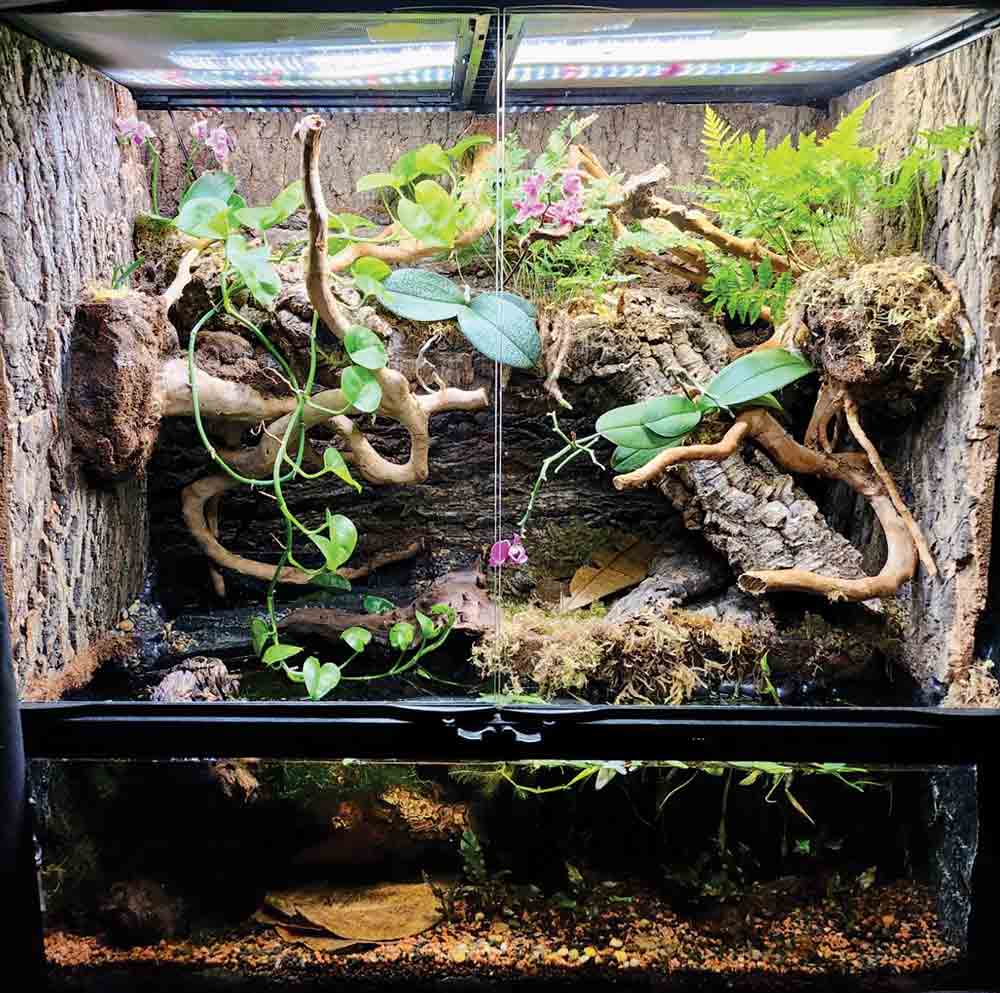
Zoo Med Large Double Door Paludarium. Photo by Foster Reves
Recently I decided that it was time to begin the process of upgrading my enclosures. While functional, converted aquariums offer distinct disadvantages when compared to commercial vivariums, air flow is limited, which can lead to increased mold in naturalistic substrates. The only means of feeding and maintenance is through the top of the enclosure. Many small lizards are flighty and fast moving. Arboreal geckos and other lizards tend to run up when frightened, and I have had to chase after more than one escapee over the years. In addition very large aquariums are difficult to easily access without using a stool, requiring the keeper to practically climb inside at times for cleaning.
Having several different species in serious need of an upgrade, I decided to start with the rarest in my collection. Tylototriton kweichowensis, or the Kweichow crocodile newt. T. kweichowensis is a large, colorful, semi-aquatic species from Southern China. Crocodile newts in general are highly coveted by caudate enthusiasts, as they should be. Prior to the 2016 US ban on the importation of all salamander species, crocodile newts were only sporadically available, and almost always as wild-caught imports. While not impossible, most crocodile newts are not easy to breed in captivity, especially when compared to those more commonly available at the time, such as various Triturus and Cynops species. Tylototriton kweichowensis requires a spacious area for swimming in addition to a land area which can provide areas of shelter.
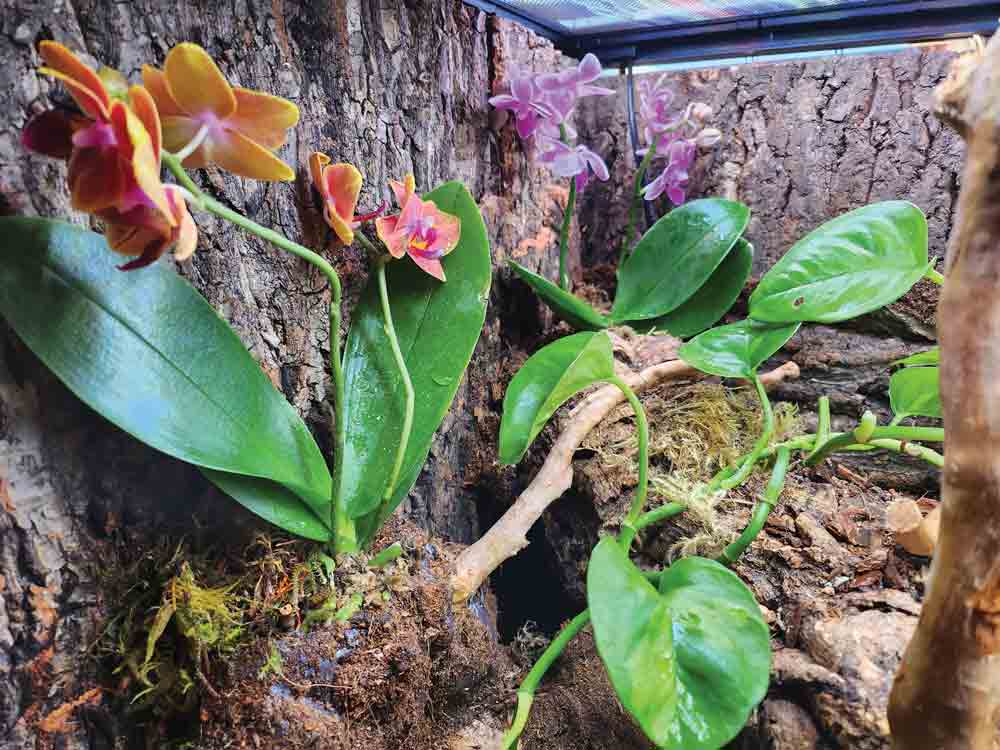
Live plants are a big part of the enclosure.
Traditionally, enclosures attempting to incorporate both land and water features were met with many challenges not present with either one by itself. Vintage texts often recommended using a standard aquarium and attaching a glass or plastic divider, making a silicone seal to keep the land area dry. These types of designs frequently ended with the soil becoming saturated with water. Additional methods have been used over the years, however one major downfall in general is that no matter the design, the amount of usable water space is generally limited when compared to the overall size of the enclosure.
When searching for potential enclosures, I looked for two major requirements, a suitable water area in order to allow swimming as well as a terrestrial section that provided more surface area than a piece of floating cork. The Zoo Med Laboratories Large Double Door Paludarium seemed like it would fit the bill. The dimensions are 36” x 18” x 36” (91 x 46 x 91 cm). The lower aquarium section holds 20 gallons (76 liters) of water. A ventilated rim divides the two areas. I decided to use this model for the upgrade since the length and width satisfy appropriate aquatic requirements.
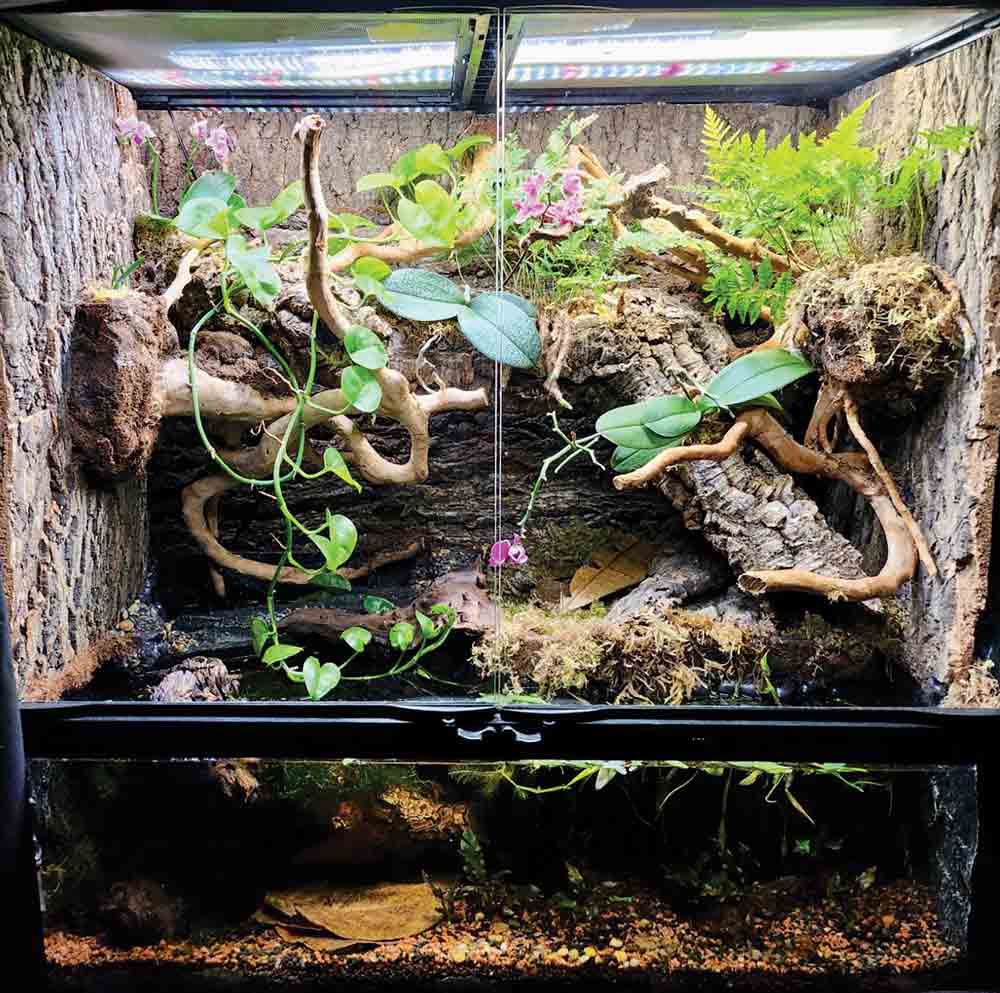
The paludarium can hold 20 gallons of water
The newts themselves have no need for most of the vertical space, however the extra height allows for more freedom when designing the terrestrial section. The option to provide an aesthetically pleasing canopy is yet another advantage. Despite the fact that no arboreal animals are currently planned for this particular setup, stratifying the vertical space was an enjoyable experience that allowed for the incorporation of another strong interest, exotic plants. I have had a lifelong interest in a variety of plant species, with a special focus on aroids, succulents, insectivorous plants, as well as ferns, bromeliads, and orchids. The vertical space accompanied by humidity generated from the aquatic base as well as the LED lighting overhead provides an ideal environment for growing epiphytes.
The paludarium is attractively packaged, adorned with various reptiles, amphibians, crustaceans, and fish species. I was impressed by the species chosen, as all are actually suitable for the paludarium. A word of caution for those housing animals in any mixed species type of vivarium, do not add more animals and plants than the enclosure size can comfortably hold. There is a tendency, especially for beginning hobbyists, to mix a number of different species together, many of which would never be compatible in terms of temperature, lighting, and humidity requirements. This trend was not aided by early commercial kits from decades ago. The author remembers box art depicting the suggestion that turtles, lizards, frogs, fish, salamanders, crabs, and other species could all be kept together harmoniously in a 20-gallon (76 liter) aquarium.
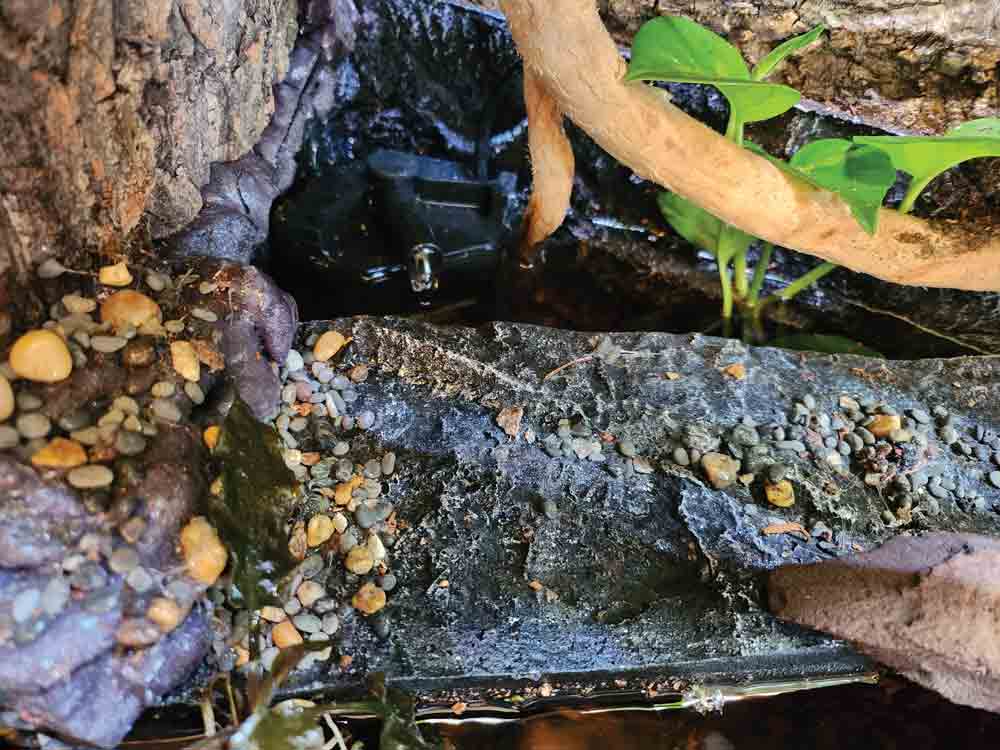
The paludarium filter.
It is absolutely vital to thoroughly research the care requirements of any species, animal and plant, in order to ensure compatibility. A 13 page booklet is included. A quick flip through gives the first impression that the manual is little more than a catalog. Reading through it however, reveals that the work is well written, with more information presented than initially presumed. While obviously other associated products produced by the company are prominently featured, five different biotypes are suggested based on difficulty of maintenance.
The description after each biotype suggests materials to be used as well as a short list of suitable potential plant and animal species. In reality, the number of plant and animal species that could be housed in this enclosure is enormous. The author is impressed that all of the species listed are proportionally small as adults, such as various nano fish, freshwater shrimp, and small Phelsuma geckos. A disclaimer reminds the hobbyist to always research the needs of any given species prior to purchase. This point is stressed in both the booklet and as part of the description printed on the back packaging. The paludarium definitely presents as a large and impressive enclosure. The marketing design could have easily photoshopped in species such large iguanas, snakes, turtles and so forth. The fact that a responsible approach was used is to be applauded.
Beginning the setup, the first step was to decide on a suitable location. As with any aquarium, the paludarium will be very heavy once filled with water. I chose a space on one of my metal framed aquarium stands. Incorporating the background was next. The back packaging of the unit doubles as an attractive backdrop featuring a print of bromeliads and other plants.This could be used as a background if it suited one’s taste, however I wanted something more natural. My first thought was to investigate the possibility of a commercial foam insert. None on the market allow for plants to be easily placed directly on the wall however.
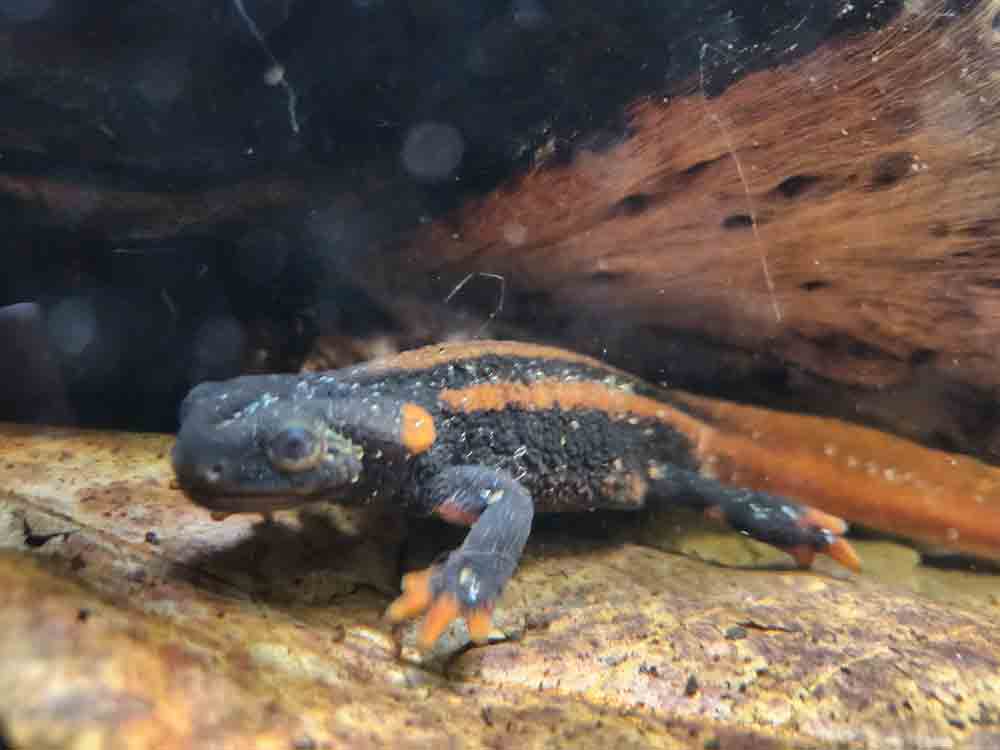
The Kweichow crocodile newt
Zoo Med manufactures cork bark panels designed specifically for this enclosure. The silicone sealant is safe for aquariums and was used to adhere the cork panels to the glass. Likewise for the aquatic section I wanted something more three dimensional than a print. The 3D slate background contrasts well with the light brown color of the cork and was used to cover the back and sides of the aquatic section, again using silicon to hold the sections in place.
The next step was particularly frustrating since I could not decide how I wanted to hardscape the canopy. Cork bark has been used extensively with keeping reptiles, amphibians, terrestrial invertebrates, and mounting epiphytic plants for years. Cork bark is natural looking, lightweight, rot-resistant and very versatile.
Years ago, I read an article by Philippe de Vosjoli in ”The Vivarium Magazine” detailing how to create an epiphytic branch using a cork tube. Mr. de Vosjoli’s work served as inspiration. I fixed a large, branching cork round in place using the expanding foam. The foam was also used inside the round in various sections in order to hold the substrate into place. To further add to a natural appearance, as well as break up the visual homogeny of all of the cork, spider wood was added next.
Spider wood is the trimmed sections of Rhododendron roots which have been pressure washed and heat treated. Changing my mind multiple times, I finally decided on how I wanted to position the branches. Expanding foam was again used to hold the wood in place. In order to subdue the appearance of the dried foam, a glue brush was used to apply the silicone to most exposed areas and then I pressed in dry Eco Earth.
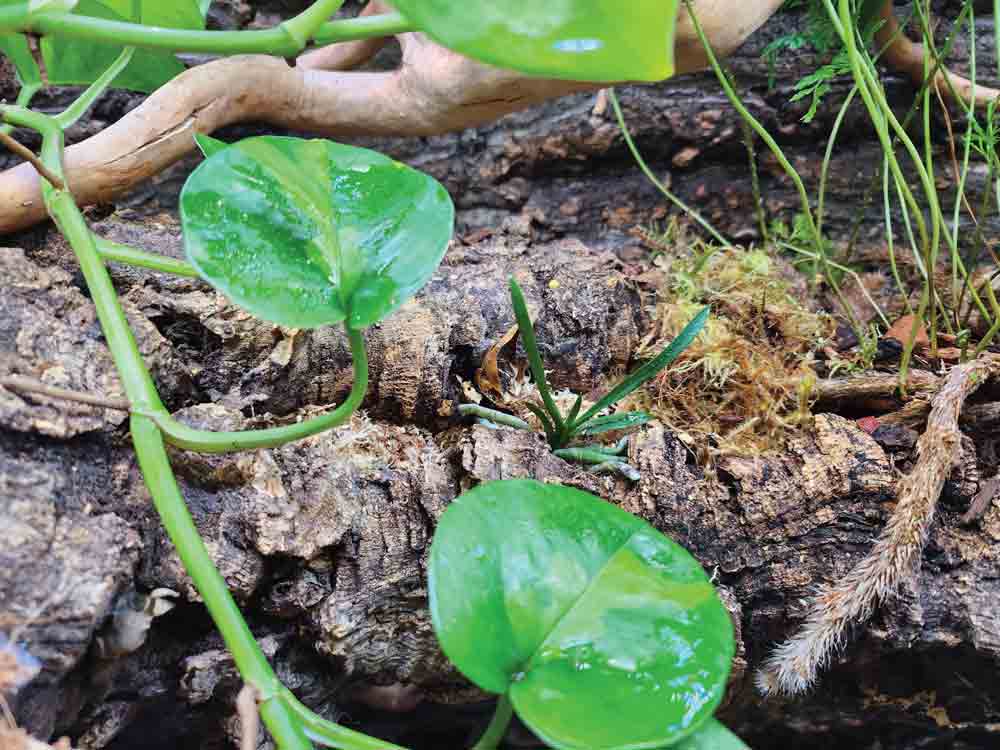
Cork bark with added plants.
Lighting is provided by a LED aquarium strip that I already had on hand. In addition, the Zoo Med Aqua Effects Model 2 LED light was also utilized. This lighting unit has an output of 850 lumens and comes with a remote control that adjusts the various settings as well as the sound feature. When I turned it on I was surprised to hear the sounds of a waterfall as well as various animal calls. Initially I thought that this was somewhat irritating (the sound feature can be turned off) but honestly I quickly came to enjoy it. The sounds are soothing and add another dimension to enjoying the paludarium. This is another prime example of the amazing advances in herpetocultural technology.
The next step was to incorporate the platform. The Zoo Med Paludarium Platform is solid black in color which blends in well with the backgrounds used. The depth is enough to provide some substrate but not really deep enough to allow planting for any species with a long root system. It will allow for the climbing vines to take hold however and vivarium friendly plants with shallow roots should do well in it. While physics does not allow for a platform base to be placed over the aquatic section while simultaneously allowing light to cover the entire bottom, the recessed design keeps dark spots to a minimum. This area can even be utilized as a modified shelter, allowing the newts to escape the light while submerged if so desired. Despite the fact that the color blends in well as previously stated, the rectangular shape is still the most artificial looking component of the system.
Since my goal is to make everything in the paludarium look natural, I wanted to devise a way to conceal the straight lines and sharp corners as much as possible. I again used expanding foam to affix the platform to the rear corner of the paludarium. This provided a more rounded appearance to the back edge. In order to give the newts an additional ramp to easily exit the water I used a leftover section of the black foam background and attached it to the platform, again using expanding foam. A small piece of Mopani wood was also siliconed into place.
In addition, dried moss was attached to the exposed plastic using the silicone. In time plant growth should serve to further break up the view of the exposed corner. Substrate used includes a layer of Reptisoil covered by live green moss. Traditionally I have preferred homemade substrates however given the ingredients of Reptisoil it was decided to be tested. Reptisoil contains humus, sand, peat moss, and coconut carbon. This mixture can easily be made bioactive and is admittedly more convenient than preparing homemade substrates.
The newts would be just fine with moss alone however I wanted to provide the soil for the isopods as well as for the living moss to grow on. Indian almond leaves and a section of cork bark are used both for decoration and shelter. The platform supports are visible in the aquarium section. Once the aquatic plants begin to fill out these will be concealed from view.
Next it was time to add the bottom substrate. A mixture of the listed ingredients was used so the substrate would be light enough to contrast against the black background but not so much that it did not blend well.
Placing the filter was the next step. In my other aquaria I almost exclusively use air-driven sponge filters, coupled with consistent partial water changes, to maintain water quality. Initially hesitant to use a mechanical filter, I did opt to try out the paludarium filter. This unit is designed to be used in tall enclosures. The extended power cord is easily looped over the back rim through a specifically designed small opening and plugged into a nearby receptacle.
My concern was that any potential shrimp offspring may get sucked into the filter intake. After examining the design however this fear was alleviated. The intake opening is well guarded and the first compartment of the multi-sectional filtration system is a sponge.
Flow rate is easily adjustable by a dial on the top. This filter also comes with extra components to allow for a waterfall feature if desired. Regular partial water changes are still important however and will certainly be implemented.
Mopani wood was used in the aquatic section. Mopani wood is an African hardwood frequently used in vivariums and freshwater aquariums. In addition to aesthetic appeal, Mopani wood sinks immediately and no pre-soaking or additional weight is required. One initial disadvantage that I soon discovered is that Mopani wood can leach tannins if a large piece is used. The water will clear in time.
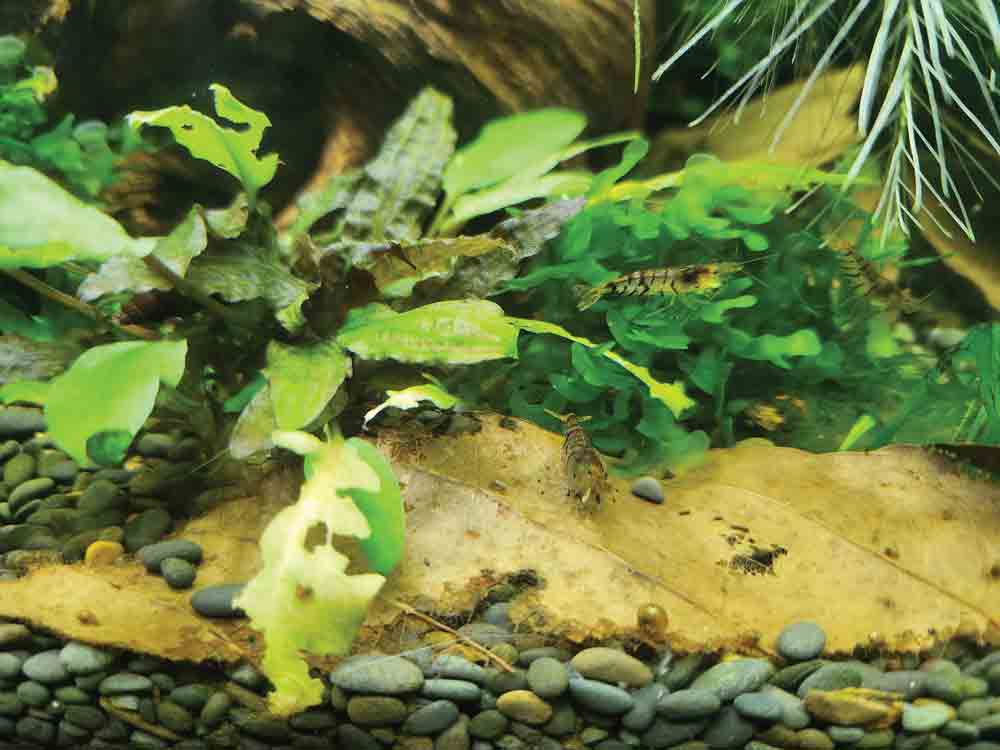
Freshwater shrimp added to the enclosure.
Once the Mopani wood was positioned in a manner that I was satisfied with, it was time to start planting the epiphytes. The canopy plants needed to be positioned into place first before adding water so that any residual planting media falling to the bottom could be easily cleaned up without making more of a mess.
As stated previously, a mixture of cork bark and chopped sphagnum moss was used, filling in the hollow sections of the cork round as well as the pockets I created using the expanding foam.
I wanted to incorporate elements of Zen design into the overall layout, particularly the aspect of grouping in odd numbers. While I had no delusions of trying to produce something as awe inspiring as an Amano aquarium, I still wanted to create a natural looking appearance. It is not always common to look at a tiny piece of forest or stream and see a multitude of different plant species.
The author chose to add only types of plants in each section in order to better replicate a slice of nature, as opposed to a botanical garden display of numerous species.
From the standpoint of the newts, it does not matter if there are bromeliads or Nepenthes growing above; however the author’s vision for this build is to promote an at least generalized Asian theme, both with the plant and animal species.
Epipremnum aureum ‘Global Green’ was chosen as the foundation species. ‘Global Green’ is a beautiful but less common cultivar of Devil’s Ivy, with chartreuse and grass-green variegated leaves, yet it retains the many positive qualities of the more common variety. E. aureum grows quickly, vining throughout a vivarium. The plant is tolerant of a wide variety of lighting conditions but will produce larger leaves under bright light. In addition, adventitious roots will grow into the aquatic section and serve to aid in prohibiting excessive algae growth as well as promote water quality. E. aureum grows so well that eventual pruning will be required from time to time.
Perhaps the quintessential forest plant is a fern. There are many species of ferns suitable for the vivarium. I chose the Dwarf Rabbit’s Foot Fern (Davida fejeensis). D. fejeensis is native to the Fiji Islands in Oceania. This fern is epiphytic, does not grow too large, and boasts neat looking, hairy scaled surface rhizomes that give it the common name.
Compact Dendrobium orchid cultivars were chosen to add both visual appeal and color when in bloom. I had a single Neofinetia falcata ‘Amami Island’ miniature orchid on hand and decided to also incorporate this into the canopy. The high humidity and position under the lights promote optimal growing conditions.
With all of the canopy epiphytes in place it was time to concentrate on the lower aquarium section. Gravel, filter, and Mopani wood were already in place. I filled in dechlorinated tap water to the demarcation barrier. This line is clearly evident on the front wall of the enclosure, clearly marking the uppermost portion of the aquarium section so too much water will not be poured in.
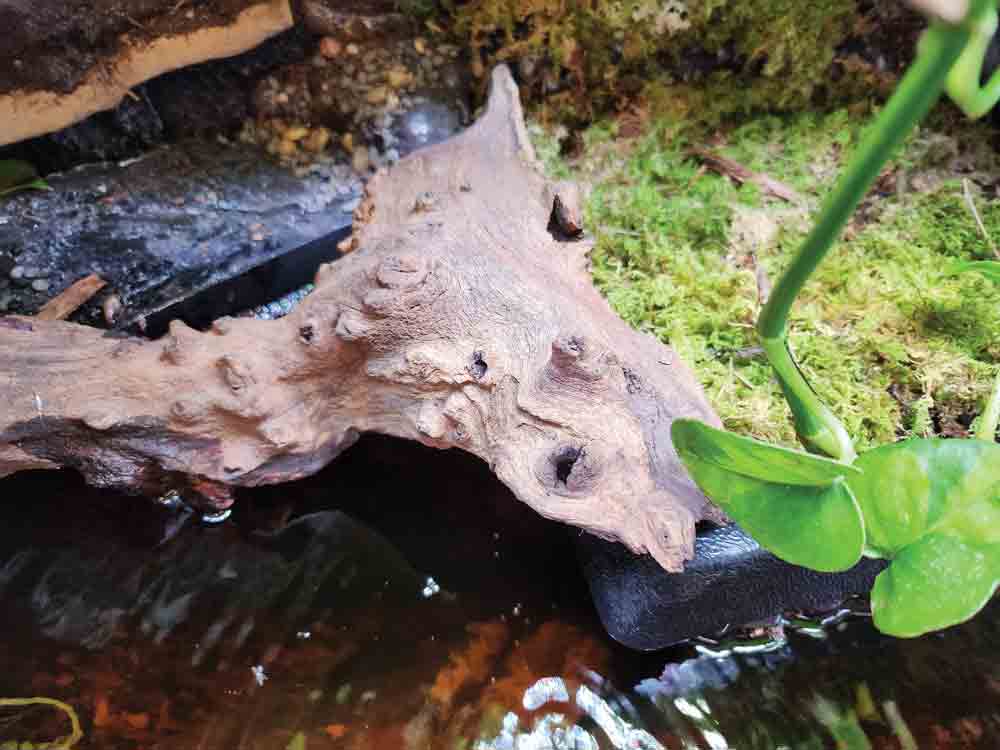
Moping wood
Normally I would have put the aquatic plants into place before completely filling the aquatic section, however timing in shipping combined with the need to get the system up and going influenced my decision to add the plants after filling the tank.
As with the canopy, I decided on three groups of plants for the aquatic section. I wanted to have a rooted species, a moss, and a floater. Cryptocoryne wendtii ‘red’ was decided upon for the rooted species. I have grown green C. wendtii for many years in my other aquaria with no special needs other than regular partial water changes and occasional thinning.
Taiwan moss (Taxiphyllum alternans) is one of several species of aquarium moss currently popular on the market. Having grown Java Moss for decades now I decided on experimenting with a different species this time. Floating Buddha (Hygroryza aristata) is a neat looking floating grass species that is reported to do well in home aquariums with adequate lighting. Native to countries across Asia, the leaf shape combined with floating nature make for a nice stratification of the water column.
With all of the plants now in place and the filter running, it was time to be patient and allow the system to cycle in.
Why Enclosure Design Matters
How To Build A Bioactive Enclosure For Your Crested Gecko
The only other animals that I chose to add in with the newts at this time are one species of freshwater shrimp and one species of terrestrial isopod. Given the rarity of Tylototriton kweichowensis in the US, the decision was made to not include any species of fish in the paludarium. Under other circumstances the white cloud mountain minnow would in all likely do well in this setup. Tanichthys albonubes are a hardy species that prefer cooler water temperatures enjoyed by most newts. Given the hopeful possibility that the newts will again produce eggs, it must be recognized that even the smallest species of fish can potentially be a threat to reproduction.
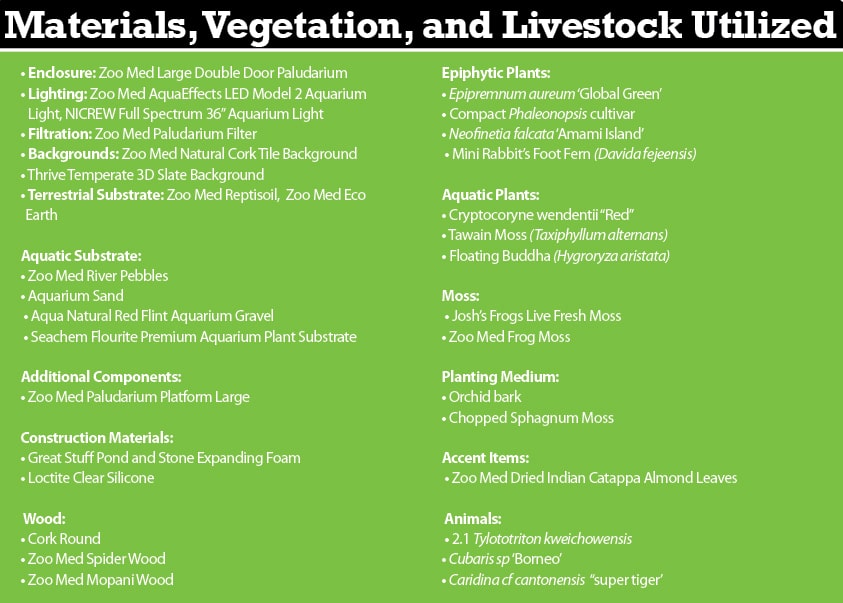
Caridina cf cantonensis ‘super tiger’ is a shrimp native to Southern China. This species was chosen not only for its beauty–a black striped body with a yellow head and tail–but also for the preference for cooler temperatures. Tiger shrimp do well at room temperature and do not require any additional heat.
Many serious amphibian hobbyists have been keeping isopods in naturalistic enclosures for years, long before the recent explosion in popularity that these little invertebrates are currently enjoying. Cubaris sp ‘Borneo’ is a smaller species that enjoys humid environments. Not as colorful as others popular in this Genus, these isopods are attractive in their own right, are small and will breed well once established. In addition to providing bioactive properties to the soil, isopods can serve as a supplemental food source.
While constructing the build I found myself wishing that I had the time and space to devote to more units. There are a multitude of possibilities of plant and animal combinations. My mind would race with thoughts of constructing environments for other species. African dwarf frogs (Hymenochirus sp), Chinese water skinks (Tropidophorus sinicus) various aquatic snakes, an array of fish, aquatic invertebrates, tree frogs, small arboreal lizards, Nepenthes, Tillandsias as well as many bromeliads in general, Ant plants (Hydnophytum sp), Shingle plants (Rhaphidophora sp), epiphytic ferns, orchids, the list goes on.
In summary, I highly recommend the Zoo Med Large Double Door Paludarium. An additional background option for those that may not have time for a DIY build would be nice, but this aside, the paludarium is a stunning display piece and makes for a stand-out addition to any reptile or aquarium room. The accessory products promoted by the company, while not essential depending on one’s plans, integrate well with the unit. Compared to the cost of large aquarium setups, the suggested retail price is very reasonable, especially given the number of potential species that can be kept. A carefully planned and constructed setup can easily rival many zoo and public aquarium displays.
Foster Reves is a freelance writer, Registered Nurse, and lifelong enthusiast and breeder of reptiles, amphibians, invertebrates, fish, and plants. Foster lives in SW Virginia with his wife, two children, dogs, cats, pet rats, as well as an assortment of other creatures. Questions and comments about this article can be sent to foster_reves@yahoo.com

